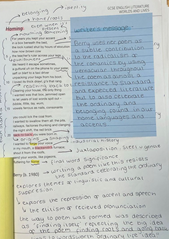Three recent conversations:
Conversation on an EMC course:
Teacher: Our students are quite good at the E and E. The problem is P. They’re really not very good at P.
Conversation in an F.E. College:
Teacher: We now have a seven-letter acronym to remind students what to put into a critical paragraph.
Me: Wow. What do all the letters stand for?
Teacher (shrugs): Can’t remember them myself. Which is why I won’t be using it with my classes. I don’t even like PEE really, but how else can you teach paragraphing?Conversation with top set year 7:
Yr 7a: We hate PEAL. Especially ‘A’
Me: What’s ‘A’?
Yr 7a: Analyse. Analyse is tedious.
Yr 7b: We don’t do ‘A’. We don’t really get ‘A’.
Yr 7c: ‘A’ on poetry is the worst. I mean, who does that to a poem?
Yr 7a: You do training with teachers. Please, train them to stop using PEAL!
These three conversations suggest some fundamental issues that need addressing when teaching essay writing. First, are we teaching too much formal essay writing too early? Second, are we confusing students about what they need to do? Third, how helpful are acronyms and highly formalised writing constraints, and what other approaches could we use to teach paragraph structure?
In working with CLPE on their reading scale, an increasing emphasis on critical reading is one of the key differences we noted between what English looks like in KS2 and what English looks like in KS3 and beyond. Analysing a text requires higher order thinking skills and pupils need time and thoughtful teaching to develop these skills. There isn’t much point in teaching a pupil to write a critical paragraph before they have something substantial to say about the text.
A formal essay is also a strange beast, full of unfamiliar conventions, which presents many challenges to the average Year 7. Those of us ancient enough to remember when AQA gave students the option of responding orally to one of their GCSE coursework texts may well remember that many achieved a grade higher in that piece than in any of their written essays. Research by Fiona English in Student Writing and Genre suggests that even undergraduates develop and express their ideas better when given forms other than the traditional essay in which to do so. Giving students other ways to develop and express their ideas about texts before they try to get a handle on the formal essay might work better, for example through oral work, transformative writing, writing without an imposed structure, hot seating and so on. If you haven’t already read it, you might be interested in Richard Long’s blog in which he explains how he used blogging to develop his students’ critical reading.
Meanwhile, you can be training your students to think like critics whether they are discussing a text, responding orally, or in writing. If they make a point and you ask them to explain what it was in the text that made them respond as they did, or prompt them to ‘tell me more about that’, or open them up to the idea of different readings with ‘what do other people think about that?’ or ask 'how does that fit in with what you've noticed about the whole text?' you are training them to think like critics. Sometimes you will have done this in discussion and sometimes they will have been asked to write their response. For some ideas about how to prompt this kind of thinking and how to use exploratory writing, see Barbara Bleiman’s blog.
Should we then be using approaches like PEE to get students ready for what examiners want at GCSE? AQA have consistently sounded a cautionary note about the over-reliance on PEE in their examiners' reports, for example:
Candidates can also have their achievements in this assessment objective undermined by over-reliance on simple PEE-type responses. Whilst this approach does provide a structure which is helpful in learning how to approach exam responses, it is a scaffold which should be removed once the candidate is more secure. It is also a strait-jacket for more able students who should be encouraged to move freely around and between the poems, writing in a deeper and more developed fashion as they pursue their own ideas about the texts. However, a ‘developed’ response is not one in which the candidate says the same thing in several different ways: ‘Cannons to the right of them...in front of them. This shows that they are surrounded by cannons which means they are in danger, the imagery is that you are able to put yourself in the position of being surrounded by cannons. The word ‘cannons’ is used to show that they will probably die because cannons are dangerous and can kill you. So it shows clearly the element of danger”. This, despite the apparent elaboration, remains a basic Band 2 ‘explicit meaning’ and is not an example of what is meant by “saying a lot about a little”.
Setting aside PEE then, what are some good approaches to teaching critical writing? There are two ideas, below, for teaching the crafting of paragraphs.
Modelling
I know, this is not exactly ground-breaking advice. However, I justify my mentioning it for two reasons: firstly, modelling is supported by robust research (for example, Santangelo, T. and Olinghouse, N. 2009); secondly, it isn’t always done in the way the research shows to be effective.
Students are often given ready-made models to look at. This approach is like trying to teach a class to bake a chocolate cake by buying them one. It’s helpful to know what the finished product should look and taste like, but quite hard to extrapolate the ingredients and method, and pretty intimidating if the cake came from Patisserie Valerie. (Does it show that I started writing this after watching ‘Bake Off’?)
At this point you may be thinking ‘but doesn’t a formula like PEE give them the ingredients at least?’ You may indeed find that this is the case when a class are first getting to grips with essay writing, and of course you know your students. However, research from Carol Sue Englert, amongst others, suggests that taught models which are close to real models are the most effective. Using an overly simplified formula like PEE may quickly become counter-productive as students progress, a straightjacket rather than a support. As the Year 7s might say ‘I mean, who does that?’ Certainly not professional essay writers. I challenge you to send me an essay by a respected academic/critic written entirely in PEE paragraphs. I’ll bake you a chocolate cake if you can find one!
The really valuable kind of modelling is when the teacher writes ‘live’ in a realistic way, thinking aloud to make explicit what they are doing to arrive at a finished paragraph. This teaches the meta-thinking which emerges so well in the research – students get to see and hear how an expert in writing critical paragraphs goes about it, like watching a TV chef show you how to make the cake. Although originally introduced in primary schools, I’ve found that older students, even up to A Level, really engage with this kind of modelling and find it both interesting and useful.
If writing ‘live’ in front of a class is about as terrifying to you as taking your clothes off in public then you can practise at home and write yourself a script – it really is worth the time it takes, and of course the lesson can then be used again. Just don’t be tempted to tidy it up. Show your workings. Include the parts where you say to yourself ‘that’s not quite right… I’m not sure how to say that…’ Apart from anything else this will encourage students to work and re-work their paragraph rather than thinking they have failed unless their ideas emerge fully formed and polished, which is the message they receive from looking at a perfected, ready-iced paragraph. If possible, expose students to other teachers’ ways of approaching the writing of a paragraph to encourage them to find their own way of doing things.
Providing the content
When teaching students to craft a paragraph for a critical essay, it’s useful to focus on expression and structure and take away the pressure to create content at the same time. One way to do this is by providing statements for them to select from and organise into a paragraph. Try out your statements before you give them to students to ensure that it’s possible to create more than one version of the paragraph. As they manipulate the statements, students are having to think aloud, explaining and justifying their choices to their partner as well as hearing how someone else would go about the same task. Encourage them to think about how to link their sentences and tweak the statements so that the paragraph flows. If they are then given the opportunity to share their paragraphs, you can use this opportunity to open up discussion about both the process and the end product. As students get more experience you can add irrelevancies for them to weed out, or the same point expressed in better or worse ways for them to consider. Click here for an example: statements to help students to write an essay about To His Coy Mistress.




